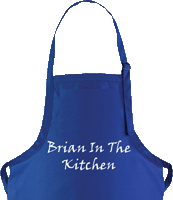Brian in the Kitchen Recipes


BRIAN IN THE KITCHEN brought to you by Stittsworth Meats
September 18 2009
Technique Week - How to Re-Heat
Do It in a Flash
Food can be cooked either "a la minute," literally meaning "to the minute," or to order; or food can be made ahead of time and then reheated for service. The latter technique, known as "flashing," is a used everyday by restaurant chefs and caterers so that they can serve large quantities of hot food without having to time the cooking of it all at the last minute. The principle of flashing is to reheat room temperature or slightly warm food in a very hot oven for a short period of time. This enables food to reach its desired temperature while preventing further cooking. Foods can be flashed from 425 to 475 degrees F, anywhere from 2-10 minutes.
What Can I Flash?
It is far easier to list what cannot be flashed, rather than what can. Stews and thick casseroles cannot be flashed from room temperature because of their density. Whole birds and roasts also will not flash well for the same reason. However, if a precooked bird is broken down and placed on a sheet pan, it can be flashed easily. Since flashing is hot and quick, the food should be in individual portions or slices, or in a thin layer. If the food is supposed to be moist and juicy, like meat and poultry, cover it with pan juices and then tin foil when flashing so that the high temperature does not dry out the product.
But I Reheat at 350 Degrees F All the Time
350 degree F is probably our most familiar oven temperature, and therefore falls right in the sweet spot of our comfort zone. It is important to remember that 350 degrees F is a baking and cooking heat, not necessarily a temperature that is ideal for reheating. In order to get precooked food hot again by placing it in a 350 degree oven, the food would have to stay in that oven for 20 minutes or more. The problem with that time frame is that the food is not really reheating, but cooking once again. Moreover, it is taking more time than necessary, which is ultimately a waste, especially when you are preparing for a party. If you cook food ahead of service, presumably you have cooked it to the desired state. When you reheat it, all you want to do is get it hot, not cook it further.
To Precook or Not to Precook
Determining what to precook and what to cook "a la minute" takes experience. But there are a few questions you can ask yourself to guide you to make the right choices:
-What takes the longest/fastest to cook?
-What is most likely/least likely to dry out?
-Will anything stay warm once cooked?
In the example above, a chicken, a casserole and two side dishes (say, roasted potatoes and roasted asparagus) will be served at a party. The potatoes should be made first, since they will cool quickly and therefore reheat quickly, but are not as likely to overcook like the asparagus (ideal for flashing!). Casseroles not only almost always can be made ahead of time, but they are generally even better that way.
The casserole should be made right before the chicken, so that it can settle and rest outside the oven, but still stay warm while the chicken is cooking. The chicken, which can dry out easily, should be roasted so that it is resting outside the oven right before you sit down to dinner. Once the chicken is removed from the oven, bring the temperature to 425 degrees F, roast your asparagus at the same time you return the potatoes to the oven for flashing (the casserole can go in the oven then, too, since it is still internally warm).